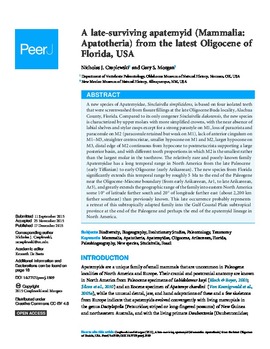| dc.description.abstract | A new species of Apatemyidae, Sinclairella simplicidens, is based on four isolated teeth that were screenwashed from fissure fillings at the late Oligocene Buda locality, Alachua County, Florida. Compared to its only congener Sinclairella dakotensis, the new species is characterized by upper molars with more simplified crowns, with the near absence of labial shelves and stylar cusps except for a strong parastyle on M1, loss of paracrista and paraconule on M2 (paraconule retained but weak on M1), lack of anterior cingulum on M1–M3, straighter centrocristae, smaller hypocone on M1 and M2, larger hypocone on M3, distal edge of M2 continuous from hypocone to postmetacrista supporting a large posterior basin, and with different tooth proportions in which M2 is the smallest rather than the largest molar in the toothrow. The relatively rare and poorly-known family Apatemyidae has a long temporal range in North America from the late Paleocene (early Tiffanian) to early Oligocene (early Arikareean). The new species from Florida significantly extends this temporal range by roughly 5 Ma to the end of the Paleogene near the Oligocene-Miocene boundary (from early Arikareean, Ar1, to late Arikareean, Ar3), and greatly extends the geographic range of the family into eastern North America some 10° of latitude farther south and 20° of longitude farther east (about 2,200 km farther southeast) than previously known. This late occurrence probably represents a retreat of this subtropically adapted family into the Gulf Coastal Plain subtropical province at the end of the Paleogene and perhaps the end of the apatemyid lineage in North America. | en_US |
